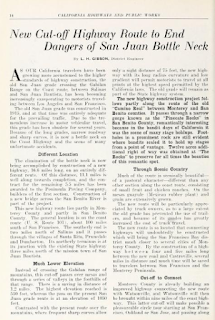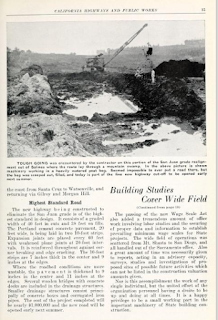The Pinecate Rocks are a geographical feature found along US Route 101 in western San Benito County in the Gabilan Range. The Pinecate Rocks are an often-cited location of numerous bandit holdups during the California Gold Rush. The Pinecate Rocks became part of US Route 101 when the highway was realigned past them during July 1932. Pictured above as the blog cover is a then two-lane US Route 101 passing by the Pinecate Rocks during 1932.
Part 1; the history of the US Route 101 Pincate Rocks
The Gabilan Range between what is now San Juan Bautista and Salinas Valley was first explored during the second Juan Bautista De Anza Expedition of Las Californias. The De Anza expedition likely crossed very close to the present alignment of Old Stage Road their exact path isn't clear. Juan Bautista De Anza noted the following in his journal while passing near present-day San Juan Bautista on March 24, 1776:
"In the valley we saw many antelopes and white grey geese. In the same valley we found an arroyo...and then came to a village in which I counted about twenty tule huts. But the only two people we saw were two Indians who came out to the road and presented us with three fish more than a foot long."
In time the general route of the second De Anza Expedition became the path of El Camino Real ("The Royal Road"). The route of El Camino Real was intended to solidify a path of travel between the Catholic Missions of Las Californias. In 1797 Mission San Juan Bautista was founded which led to a need for a spur of El Camino Real to be built from Salinas Valley over the Gabilan Range. This spur of El Camino Real would become what is now Old Stage Road. While the Spanish El Camino Real was largely just a general path between the Missions there are several paths such as Old Stage Road which can be identified conclusively as part of the highway.
In 1804 Alta California was formed out of the larger Las Californias. El Camino Real would ultimately connect 21 Catholic Missions of Alta California ranging approximately 600 miles spanning from Mission San Diego de Alcala in San Diego north to Mission San Francisco Solano in Sonoma. The Missions of El Camino Real were established from 1769 through 1823. In the case of Mission San Francisco Solano, it was established two years after Mexico had won its independence from Spain in 1821. Each Mission was meant to be approximately 30 miles apart from each other which would require a single day of travel by horseback.
Following the advent of Mexican independence from Spain the usage of the term "El Camino Real" largely fell into disuse. Following the secularization of the Spanish Missions during August of 1833 the land holdings were split off into Ranchos. Despite El Camino Real functionally no longer existing the route's path over what is now Old Stage Road remained a popular route of travel over the Gabilan Range. What is now San Juan Bautista was founded as a town in 1834 known at the time as "San Juan de Castro."
Alta California was annexed by the United States in early 1848. San Juan Bautista became an incorporated City in 1869 (citation; San Juan Bautista Historical Society). San Juan Bautista was originally located in Monterey County but was among the land split into San Benito County in 1874. Old Stage Road remained the primary route of travel between Salinas Valley and San Juan Bautista into the 20th Century.
Old Stage Road shows up numerous maps as a primitive road. One such example is this 1857 Britton & Rey's Road Map of California.
Likewise Old Stage Road appears on the 1873 California Geological Survey Map of Central California as the road between Salinas Valley and San Juan Bautista.
In 1904 the American El Camino Real Association was formed with the goal to mark a modern highway that corresponded to the historical route between the Spanish Missions. Ultimately the path of American El Camino Real was to be marked by the signature bells the corridor is known by today. The first bell marking the American El Camino Real was placed in 1906 and it is estimated by 1915 that there may have been anywhere to 158 to 400 placed in-field. The American El Camino Real was one of the earliest analogs of what would become the signed Auto Trails. The American El Camino Real just as its Spanish predecessor crossed the Gabilan Range via Old Stage Road. The background of the American El Camino Real is covered extensively on CAhighways.org.
CAhighyways.org on the American El Camino Real
The era of State Highway Maintenance through the Gablian Range would ultimately begin with the 1909 First State Highway Bond Act which was approved by voters in 1910. One of the highways approved through the 1909 First State Highway Bond Act was a 481.8-mile highway originating at the City Limits of San Francisco which terminated in San Diego. This highway would ultimately come to be known in time as Legislative Route Number 2 (LRN 2).
Old Stage Road even by the conventions of the 1910s was woefully inadequate for usage by automobiles. The terrain of the Gabilan Range between San Juan Bautista and Salinas Valley was so rugged that an alternate route from Gilroy to Salinas by way of Watsonville and Castroville was considered. The proposed highway routings of LRN 2 are featured in the January 1913 California Highway Bulletin.
The rationale for selecting the routing of the San Juan Grade through the Gabilan Range (referenced as San Juan Mountain) is noted to be three-fold in the January 1913 California Highway Bulletin. The route through the Gabilan Range was the most direct and particle route between Salinas Valley-Santa Clara Valley, within seven miles of the San Benito County seat of Hollister and had an estimated gradient ranging from 2-6%. The existing route of American El Camino Real over Old Stage Road is noted to be direct, and it would be desirable for LRN 2 to follow nearby over a better grade.
The January 1913 California Highway Bulletin noted $75,000 in bonds had been sold which funded construction of the San Juan Grade.
The July 1914 California Highway Bulletin noted surveys for the San Juan Grade were complete in San Benito County and in Monterey County. LRN 2 from the Monterey County Line to San Juan Bautista is noted to be in the process of construction as an unpaved road. A contract to construct LRN 2 in paved Portland Cement north of San Juan Bautista is noted to have been awarded on July 6, 1914.
The January 1915 California Highway Bulletin noted LRN 2 had been completed over the San Juan Grade from the Monterey County Line north to San Jaun Bautista. The San Juan Grade despite not yet being paved immediately saw service as a replacement for Old Stage Road. LRN 2 north of San Juan Bautista north to the Santa Clara County is cited to have gone through the process of a rejected contract and was now being constructed via prison labor.
The unfinished new alignment of US Route 101/LRN 2 past the Pinecate Rocks are featured in the December 1931 California Highways & Public Works.





































Comments